Almost any indoor environment is more pleasant and attractive when living plants are a part of the setting. In apartments, condominiums and single family residences, plants add warmth, personality and year-round beauty. Shopping centers, hotels and resorts take full advantage of the colorful, relaxed atmosphere created by green growing things. Offices, banks and other commercial buildings rely on interior plants to humanize the work environment and increase productivity.
There are other important, often overlooked functions performed by indoor plants. These include directing or controlling pedestrian traffic, subdividing or enclosing space into separate areas, reducing glare and reflection from strong lights and screening to block out undesirable views or to create privacy. Real enjoyment and consistent success with indoor plants depends on selecting the right plant for a given environmental situation. Light, temperature and humidity are key considerations. Often one or more of these will be less than ideal. However, by being aware of the shortcomings of an indoor location one can usually alter them or match plants with growing conditions. In addition, a good soil mix and proper watering and fertilization are important for healthy plants.
Light
Light is essential for plant life processes, and optimum levels ensure healthy, long-lived indoor plants. In general, there are three categories of light intensity for interior plants: high, 150–1000 foot-candles (fc); medium 75–150 fc; and low, 25–75 fc. It is important to match plants with locations that satisfy their basic light requirements. Many reference books and Cooperative Extension publications provide interiorscape professionals and home gardeners with information on the light levels necessary to maintain plants indoors. A wide variety of light meters is available for measuring light intensities in indoor environments.
Some may be purchased at relatively low cost from garden centers or from garden catalogs. Their readings of Low, Medium and High can give “ballpark figures,” and they can eliminate much of the guesswork in selecting plants that are adapted to light levels in a given location. If sunlight is the major light source you may determine which category your indoor location falls into by using the following descriptions:
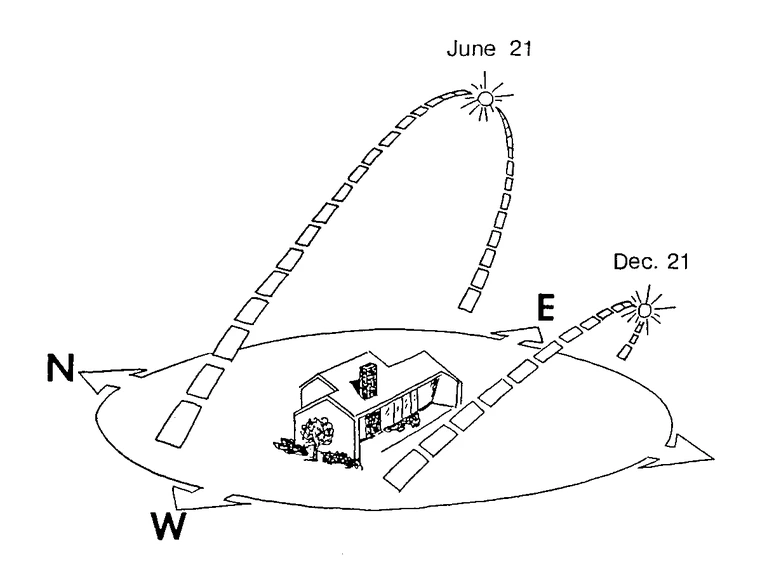
High Light: areas within four feet of large south-east or west facing windows.
Medium Light: locations in a range of four to eight feet from south and east windows and west windows that do not receive direct sun.
Low Light: areas more than eight feet from windows as in the center of a room, a hallway or an inside wall. Northern exposures often fall into this category, even close to the window. Many locations that receive only artificial light are also low light situations.
The intensity and duration of natural sunlight that reaches indoor locations varies throughout the year. In winter, days are shorter and the sun’s path is lower and farther to the south. Therefore, most plants will receive fewer hours of less intense sunlight from a more southernly angle in the winter. However, plants growing close to an unshaded south window may receive more direct sunlight at this time of year because of the low sun angle. In summer the days are longer and the sun’s path is higher above the horizon. For many plants this is the peak growth period.
Keep in mind that there are less obvious factors which affect sunlight levels indoors. These include the following: the color of interior walls and floors, types of window coverings, roof overhangs, outside awnings, nearby buildings and trees that filter or block incoming light. In addition, “office hours” are often constant year round, providing low to mid levels of artificial light for 10 hours each day Monday through Friday, with no light at all for the entire weekend.
Plants grown in their light preference are vigorous, compact and bushy. Color is vibrant, leaves are normal size, and stems are sturdy. Bloom is promoted.
Plants grown at a light intensity below their optimum will have smaller leaves and less vivid color. They often grow more open and leggy and pruning may be necessary for compact form. Keep these plants drier than those in bright light and fertilize them less often. A plant that receives significantly less than its preferred amount of light may survive for several months to a year, though gradually deteriorating in appearance and vigor.
When light levels are too high, plant leaves show an overall yellowing that results from the destruction of green pigment. In time large brown spots of dead tissue may develop. This is often referred to as leaf scorch or leaf burn.
Artificial light can be used to supplement or replace natural sunlight. Cool white fluorescent lights alone or in combination with warm light fluorescent lights are the most economical and best all-purpose lamps. Typically, a fixture holding two 40-watt tubes is positioned approxi-mately 12 inches above the plants. Most plants need 12–16 hours of artificial light per day for good growth. For large specimen plants, use spot or flood lights to maintain good appearance and accent the plant. Use a timer to turn the lights on everyday — even when you are not there. You may consider designing room lighting around your anticipated use of indoor plants. Indirect and track lighting are very effective design features for this purpose.
Temperature
Most homes and offices are heated and cooled with human comfort in mind rather than the growth requirements of indoor plants. Fortunately, the desirable temperatures for humans fall within the optimum range for most foliage and flowering plants. Daytime tempera-tures of 70–80o and a nighttime range of 60–70o are satisfactory for most species. Many flowering plants bloom longer at the cooler end of these day-night temperature ranges.
Temperatures may vary between rooms within the same building. A minimum-maximum thermometer will pinpoint such differences. These temperature variations should be considered when you are placing plants.
Sudden temperature changes caused by drafts can be harmful to interior plants placed next to doors in winter. If a plant is positioned near a window, protect it from heat and intense sunlight during the day and from cold, drafty conditions at night. Use shades and curtains or move the plant far enough away from the window to avoid temperature and light extremes. Never place plants near heat registers or fireplaces.
Humidity
Humidity may determine whether or not certain plants that are native to moist tropical regions will do well in the average indoor location. In dry air, the leaves of these plants turn yellow or show brown tips and margins. Some fail to flower while others produce flower buds that shrivel and drop suddenly from the plant.
In a moderate humidity range of 20–40%, it is possible to grow a variety of flowering and foliage plants. However, cactus and other succulents are perfectly at home in a humidity range of 5–15%. A hygrometer can be used to determine the relative humidity of different indoor locations throughout the year.

One of the simplest ways to increase the humidity around plants is to group them close together. Water constantly evaporates into the air from leaf pores (stomata) as well as from soil and some container surfaces, creating a humid microclimate in the immediate area of the plants. Another technique for increasing humidity is to place watertight saucers or trays holding an inch or two of wet pebbles under plant containers. Add water to the saucer or tray to a point just below the surface of the pebble layer. Humidity increases around the plant as this water evaporates. Make sure the water level in the saucer never rises to the bottom of the pot. If this happens, the container soil will remain constantly wet, toxic salts will accumulate at the soil surface, and roots will be damaged.
Some buildings are cooled by evaporative coolers during the summer months. This results in higher humidity and significantly better performance of interior plants from June into September. However, air conditioners tend to make indoor air drier during the summer cooling season.
Cool mist vaporizers or room humidifiers are an effective means of adding moisture to the air. In a home environment sensitive plants can be grown in more naturally humid rooms such as the kitchen, bathroom or laundry room. Many small indoor plant species thrive in the humid environment of a terrarium.
Soil
A wide range of commercial potting soils for interior plants is available. They vary in price, ingredients, and physical and chemical characteristics. It may be necessary to try several before you find one that gives good results under your conditions. The following points should help make the selection process easier.
Good drainage with adequate water retention is essential. A few rocks in the bottom of the pot is NOT a substitute for a well-draining potting mix. A fine-textured heavy soil mix that holds too much water will suffocate plant roots. On the other hand, a light, coarse-textured potting soil that drains too quickly may not retain adequate water and nutrients for normal plant growth.
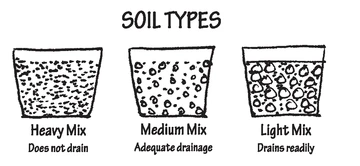
Almost all potting soils include two or more ingredients such as peat to hold water, perlite to give aeration, and bark or vermiculite to hold nutrients. These should be thoroughly and uniformly mixed for good root growth. It is quite common for soil mixes to slowly “shrink” over time, due to decomposition of organic components as well as settling. The net result is typically an increase in water holding, with a decrease in aeration (usually referred to as “souring”). Mixing in new medium periodically will freshen the pot. To do this, gently remove the entire plant, add new soil at the bottom, rough up the sides and top of the original root ball, then replace your plant, firming new soil onto surface.
Normal garden soils are not recommended for indoor plants. Besides questionable water and nutrient-holding characteristics in containers, they may contain insect eggs, weed seeds and disease organisms.
Water
Watering indoor plants is widely misunderstood. Improper watering is the underlying cause of many plant problems. There are several basic points to consider:
- Plants with large or very thin leaves and those with fine surface roots usually require more frequent watering than succulent plants with fleshy leaves and stems that are able to store water internally.
- In a warm, dry, sunny location, plants need more frequent watering than they do in cool, low-light situations. Likewise, the same plant in summer will use more water than in winter.
- A large plant in a small pot will need water more often than a small plant in a large pot.
- Flowering plants and rapidly-growing plants dry out more quickly than those in a resting stage.
- Different soil mixes require different watering sched-ules. Heavy fine-textured potting media and those that contain a lot of peat moss hold more moisture than loose, porous mixtures of bark, sand and perlite.
- Water evaporates rapidly from the sides of an untreated porous clay pot, but not at all from plastic or glazed ceramic containers. In either case, scheduling will be affected.
- Water thoroughly every time you water a plant. Apply enough water to moisten the entire soil volume, plus a little extra to move soluble salts out of the container.
- If the soil mix dries out so that it is difficult to wet again, immerse the pot up to the rim in a bucket of water. Leave it submerged for several hours, then let it drain thoroughly. This will also help to eliminate any soil-borne pests.
- Another very good way to re-wet excessively dry soils is to add a small amount of liquid dish washing detergent in water, two or three drops in a gallon, and water the plant slowly until the soil is wet.

Indoor plants are usually placed in saucers to hold excess water that drains from the bottom of the pot. If the plant is left standing in this water, the moisture will be reabsorbed into the pot. This results in root rot, salt injury, and generally poor plant performance. To prevent the problem, discard any water in the saucer after each soaking, or elevate the base of the container above the level of drainage water. One way to do this is to spread a layer of gravel in the bottom of the saucer deep enough to keep the bottom of the container out of the water.
Mulch is often spread on top of the soil in a container plant. Mulch serves to reduce evaporation, prevents soil compaction, and is attractive. However, it can also prevent the soil from drying out, and can significantly affect the watering schedule. If your plants have a layer of bark mulch (or for succulents, gravel) on them, they will need to be watered far less often. The feel of the soil should be one guide in watering indoor plants. When the top inch of the soil in containers up to 8–10 inches in diameter feels dry, the plant probably needs watering. For smaller containers, the top ½ inch will indicate the time to water. Cacti and succulents can go without water for longer periods. Many interior plants that are not given artificial light go into a resting stage during the short cool days of winter. During this season frequency of watering should be reduced. Using simple moisture meters, available at most garden center and nursery outlets, is a very good way to get a general idea of the moisture level in the center and lower part of the container soil mix. You can also watch the plant itself for signs of over-or underwatering.
Fertilizer
Fertilizers for indoor plants should contain nitrogen, phosphorus and potassium. The analysis is printed on the label and indicates the percent by weight of each nutrient in the formulation (i.e., 5-10-5). The first number represents nitrogen (N), the second phosphorus (P2O5), and the third potassium (K2O). Most plants grow vigorously with a 1-1-1 ratio (i.e., 20-20-20) fertilizer. However, you may want to increase the amount of nitrogen for a non-flowering plant.
Water-soluble fertilizers need to be measured and dissolved in water at each feeding. Granular, pill, and slow release forms are convenient for indoor gardeners. They slowly dissolve in the soil and are good for several months. Regardless of the analysis and formulation, always read and follow manufacturers’ rate of application directions. Keeping records on the kitchen calendar will minimize mistakes.
Observation will guide you in determining your plant’s fertilizer needs. As a rule, applications should be more frequent when the plants are in a growth stage. This is usually in the spring and summer when sun light intensity increases and the warm days are longer. During the short days of winter, many indoor plants that receive little or no artificial light enter a resting stage. Plants from some arid regions actually rest during the hot summer months and grow and flower during the cooler winter months. During any rest period, it’s best to give plants little, if any, fertilizer.
Plants that have just been transplanted or repotted will obtain sufficient nutrients from the fresh potting soil for at least 4–8 weeks. They do not require supplemental fertilizer during this time.
Containers
There are several points to consider when selecting a container for an indoor plant. Container size and shape are particularly important. A plant will not thrive in a pot that is too large or too small. As a rule, the diameter of the pot should be about one-third the height of the plant from the top of the foliage to the soil line. Plants with shallow roots (like cacti) grow best in shallow containers. Deep-rooted plants need more room to grow and require a taller container.
Indoor plant containers are made of many materials, but clay and plastic are most widely used. Untreated clay pots allow moisture to evaporate from the soil through the sides of the container. This promotes soil aeration and healthy roots. On the other hand, the soil dries faster and plants need watering more often in porous clay pots than in most other types of containers. Plastic pots retain moisture longer. It’s important, therefore, to ensure good drainage in the soil mix and to avoid over-watering. Plastic pots are also easier to clean, more durable, lighter in weight, and generally less expensive than clay containers. Subirrigation (self-watering) containers usually consist of a double-walled pot with a water reservoir that is filled infrequently. When properly managed, they minimize moisture stress in interior plantings, and may reduce maintenance time and cost.
The most important characteristic of an indoor plant container is that it have one or more drainage holes. This permits rapid escape of drainage water, leaching of excess salts, and re-entry of air into larger pore spaces in the lower soil. Plants grown in containers that have no drainage holes are easily injured or killed by overwatering. Pots sitting in trays to catch water should be situated above the water level. Production pots that are installed into decorative planters can sit on a layer of gravel or sand to facilitate drainage beyond the root ball.
The design of pots or containers can influence the soil characteristics, particularly drainage. A tall thin container has a layer of wetted soil at the bottom, and a large volume of aerated soil. All other things being equal, a shorter, wider container, with the same soil mix, will also have a layer of wetted soil at the bottom, but much less aerated soil. A layer of gravel in the bottom of a container does NOT improve drainage of the soil mix — it just reduces the volume of soil within the pot.
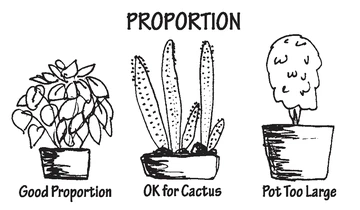

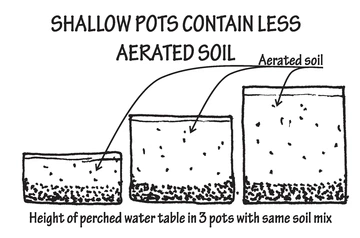
Grooming
The leaves of indoor plants can become coated with a heavy layer of dust in a surprisingly short time. This dust and grime interferes with normal leaf functions and makes the plant less attractive. Use a soft cloth or sponge moistened with warm water to clean both upper and lower leaf surfaces at least every two or three months. Disposable baby wipes without lanolin also work well for this. Plants that are small enough to move into the shower or outdoors onto the patio in warm weather for a mild soapy wash (hand dish type only!) and rinse will be healthier and less prone to insect problems.
Plant leaf-shine materials should be avoided. They attract dust, reduce light available to leaves, and can be toxic to the plant by blocking the stomata on leaf surfaces.
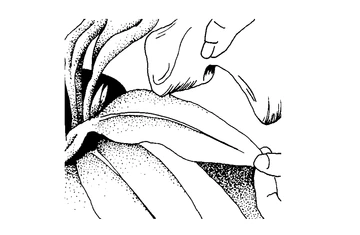
Plants should be turned regularly if possible to expose all sides to light coming from one direction. This encourages a more uniform shape. Remove yellow or discolored foliage as it develops. Dried brown leaf tips and margins may be trimmed back to green tissue with scissors. Follow the shape of the leaf when making these cuts to maintain natural appearance.
Moving plants indoors or outdoors
Houseplants can spend the warm months outdoors. Let them adjust them slowly, and do not put them into full sun during the hottest months. Light shade such as that under most trees, or under overhangs or ramadas is best. This outdoor “vacation” in the fresh air and higher light means that watering will have to be more frequent, particularly in dry climates. Be gentle when watering. Avoid high streams from garden hoses that can slosh soil from the pots.
When you bring plants back into the house, check carefully for insects, soil pests, or other potential problems that will most certainly multiply in the warm interior environment. Trim off dead or dying leaves, spent flowers, and debris. Wash all surfaces with soapy water to remove egg cases and very small insects. Soak the pot to the rim in a bucket of water as described above to eliminate any soil pests.
Environmental problems
Plants that are yellowing, producing small or misshapen leaves, or exhibiting other symptoms may be reacting to cultural mismanagement. Pests and diseases are more apt to attack plants that are stressed from too little water (or too much), inappropriate light levels, or other aspects of their environment. See the diagnosing common problems section to learn more about identifying the causes of many symptoms.
Plants for different light conditions
Low Light (25–75 fc)
Aglaonema commutatum — Silver Evergreen (several varieties)
Aglaonema modestum — Chinese Evergreen
Aspidistra elatior — Cast-Iron Plant
Aspidistra elatior ‘Variegata’ — Variegated Cast-Iron Plant
Chamaedorea elegans — Parlor Palm
Chamaedorea elegans ‘Bella’ — Neanthe Bella Palm
Dracaena deremensis ‘Janet Craig’— Janet Craig
Epipremnum aureum — Golden Pothos
Epipremnum aureum ‘Marble Queen’ — Marble Queen Pothos
Sansevieria trifasciata — Snake Plant (several varieties)
Medium Light (75–150 fc)
Aechmea fasciata — Silver Vase
Aglaonema commutatum ‘White Rajah’ — White Rajah Aglaonema
Asparagus densiflorus ‘Myers’ — Plume Asparagus
Asparagus densiflorus ‘Sprengeri’ — Sprengeri Asparagus
Asparagus setaceus — Fern Asparagus
Aucuba japonica ‘Variegata’ — Gold-Dust Plant
Brassaia actinophylla* — Schefflera
Brassaia arboricola* — Dwarf Schefflera
Chamaedorea erumpens* — Bamboo Palm
Chlorophytum comosum ‘Variegatum’ — Spider Plant Cissus rhombifolia — Grape Ivy
Dieffenbachia amoena — Giant Dumbcane (several varieties)
Dieffenbachia maculata — Spotted Dumbcane (several varieties)
Dizygotheca elegantissima — False Aralia
Dracaena deremensis ‘Warneckii’* — Striped Dracaena
Dracaena fragrans ‘Massangeana’* — Corn Plant
Dracaena godseffiana* — Gold-Dust Dracaena
Dracaena marginata* — Red-Margined Dracaena
Dracaena sanderana* — Ribbon Plant
Fatsia japonica — Japanese Fatsia
Ficus benjamina — Weeping Fig
Ficus elastica — India Rubber Plant (several varieties)
Ficus lyrata — Fiddleleaf Fig
Ficus retusa — Indian Laurel
Gynura aurantiaca — Velvet Plant
Hedera helix & cvs. — English Ivy
Howea forsterana — Kentia Palm
Maranta leuconeura erythroneura — Red-veined Prayer Plant
Nephrolepis exatata — Boston Fern (several varieties)
Pandanus veitchii — Variegated Screw Pine
Peperomia caperata* — Emerald Ripple Peperomia
Peperomia obtusifolia — Oval-leaf Peperomia (several varieties)
Philodendron bipennifolium* — Fiddle-leaf Philodendron
Philodendron scandens* — Heart-leaf Philodendron
Philodendron selloum — Tree Philodendron
Pilea cadierei — Aluminum Plant
Pilea involucrata — Friendship Plant
Plectranthus australis* — Swedish Ivy
Polyscias balfouriana ‘Marginata’ — Variegated Balfour Aralia
Saintpaulia sp., hybrids & cvs. — African Violet
Spathiphyllum ‘Clevelandii’ — Cleveland Peace Lily
Spathiphyllum ‘Mauna Loa’ — Mauna Loa Peace Lily
Syngonium podophyllum — Nephthytis (several varieties)
Tradescantia fluminensis — Inch Plant
Zebrina pendula — Wandering Jew
* may also be conditioned to grow in low light
High Light (150–1000 fc)
Aloe barbadensis — Aloe Vera
Alternanthera ficoidea — Joseph’s Coat
Araucaria heterophylla — Norfolk Island Pine
Beaucarnea recurvata — Ponytail Palm
Cissus antarctica** — Kangaroo Vine
Coleus blumei — Coleus
Crassula argentea — Jade Plant
Chrysalidocarpus lutescens — Areca Palm Euphorbia species
Fatshedera lizei** — Botanical Wonder
Hibiscus Rosa-sinensis — Chinese Hibiscus
Hoya carnosa** — Wax Plant
Iresine lindenii — Blood Leaf
Phoenix roebelenii — Pygmy Date Palm
Podocarpus gracilior — Weeping Podocarpus
Rhoeo spathacea — Moses-in-the-Cradle
Sedum morganianum — Burro’s Tail
Most succulents and cacti
** may also be conditioned to grow in medium light
Diagnosing common problems
| Possible Causes | Symptoms | |||||||||||||||||||||
|---|---|---|---|---|---|---|---|---|---|---|---|---|---|---|---|---|---|---|---|---|---|---|
blank | Foliage | Growth | Flowers | |||||||||||||||||||
blank | tips or margins brown | bend down and curl | yellowish green | oldest drop | all drop | spots | wilt | weak, thin and soft | new leaves small | none develops | plant died | failed to develop - bud drop | color is less intense | decline too fast | become smaller | no blooms | ||||||
| EXCESS LIGHT: i.e. exposure to direct sun can be too intense for many plants |
|
|
|
| X | X |
|
|
|
|
|
|
|
|
| |||||||
| INSUFFICIENT LIGHT: impairs photosynthesis and flowering. |
|
| X | X |
|
|
| X |
|
| X | X |
| |||||||||
| DAYLENGTH: if too short reduces growth and vigor, also detrimental for flowering. |
|
|
|
|
|
|
|
| X | X | X | X |
|
|
| X | ||||||
| HIGH TEMPERATURE: especially at night reduces growth and vigor, also detrimental for flowering. |
|
| X | X |
|
| X | X | X |
|
| X | X | X |
| X | ||||||
| LOW TEMPERATURE: continued exposure to adverse plant growth |
| X |
|
|
| X |
|
|
| X | X | X |
|
|
|
| ||||||
| LACK OF WATER: limiting factor or growth and survival. | X |
|
| X | X | X | X |
| X | X | X | X |
| X |
|
| ||||||
| OVERWATERING OF POOR DRAINAGE: reduces soil aeration - roots die, water, and nutrients are not absorbed. | X |
| X | X | X |
| X | X | X | X | X | X | X |
|
|
| ||||||
| TOO MUCH FERTILIZER: accumulation of soil salts injuries plant roots, reduces water uptake. | X |
| X | X | X |
| X |
| X | X | X | X |
|
|
|
| ||||||
| LACK OF FERTILIZER: causes a deficiency of nutrients required for plant growth. | X |
| X | X |
|
|
| X | X |
|
| X | X |
| X |
| ||||||
| COMPACTED SOIL: reduces root functions and activity |
|
| X | X |
|
| X | X | X |
|
| X | X |
| X |
| ||||||
| GROWING CONTAINER: too small or too large in relation to plant size. |
| X |
|
|
|
| X |
| X | X |
|
|
|
| X | X | ||||||
| LOW HUMIDITY: air too dry to maintain healthy growth and flowering. | X | X | X | X | X |
|
|
| X | X | X | X |
| X | X | X | ||||||

